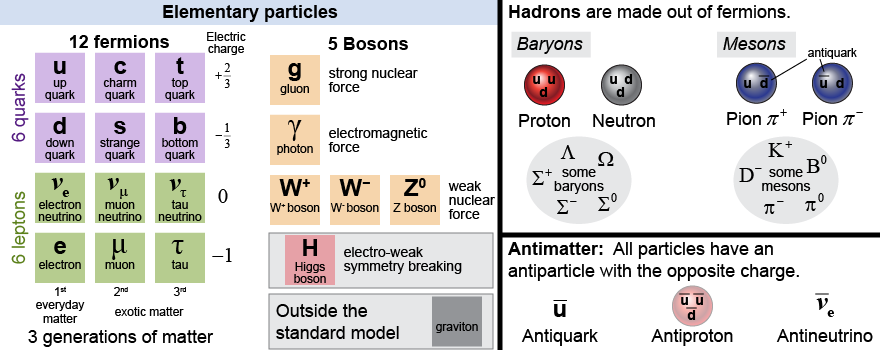|

|
In the past few decades, physicists have used ever more powerful particle accelerators to collide particles at higher and higher energies. They have discovered many new particles and have created a standard model that explains the new physics. The model is a consensus theory of particles, matter and antimatter, particle interactions (or forces), and quantum physics. Particles are classified according to their electric charge, how they interact with each other, and family (or “generation”). 
 |
The diagram above includes the graviton, which is a prediction for a boson that would mediate the gravitational force. No graviton has ever been observed; hence the graviton is identified as being outside the present-day standard model of physics. The gravitational force is so weak that an individual graviton’s effects would be virtually impossible to detect with any physically possible detector.
There are, however, experiments currently underway to detect gravitational waves directly. Exotic astronomical objects and events, such as the merger of two neutron stars, are predicted to create gravitational waves that might propagate toward Earth. The Laser Interferometer Gravitational-wave Observatory (LIGO) was designed to detect small changes in distance caused by small ripples in spacetime when these gravitational waves pass through its instrument. The experiment uses lasers that travel four kilometers through a vacuum mounted along an arm of the instrument, reflect off a mirror, and then travel back again. If the length of the instrument’s arm changes slightly, the laser light returning from this trip will be slightly out of phase with the original laser and cause interference. The LIGO project has not yet detected a gravitational wave, but scientists are hopeful that future upgrades will provide the sensitivity to do so. 
|
In the standard model, there are two kinds of elementary particles: fermions and bosons. All particles in the universe ultimately are made up of fermions. 
|
Quarks are particles that are smaller than protons or neutrons. There are six different quarks that come in three pairs: up and down, charm and strange, and top and bottom. Quarks are never seen directly or found in isolation but can only be found inside hadrons, such as protons or neutrons. Baryons, including neutrons and protons, are composed of three quarks. Mesons are composed of a quark and an antiquark. Quarks are affected by the strong nuclear force. 
|
Leptons are the other category of fermion. Electrons and neutrinos are two examples of leptons. Leptons are not affected by the strong nuclear force but obey the Pauli exclusion principle. 
|
Quarks and leptons are grouped into three different families or “generations.” Everyday matter is made up from the lowest mass group of particles, comprising the electron, the electron neutrino, and the up and down quarks. The two higher mass groups are called “exotic” because they are usually only seen in very high energy conditions, such as inside a particle accelerator. 
|
In the standard model every particle also has an antimatter opposite, an antiparticle with the same mass and other properties but opposite charge. The positron is the antimatter twin of the electron and has positive charge. Neutral particles are their own antiparticle, because they are electrically neutral. When a particle and its antiparticle twin collide in pair annihilation, a large amount of energy is released. 
|
Bosons are elementary particles that mediate (or cause) forces to happen. In the standard model, there is at least one boson for each of the four forces of nature. 
 |
If this textbook had been written several years ago, the Higgs boson would not have been included in the figure at the top of the page! The Higgs particle had long been predicted, but it had never been detected because existing particle accelerators could not reach sufficiently high energies. A particle of approximately the correct mass has been detected by the Large Hadron Collider at CERN along the border between France and Switzerland. It is currently suspected to be the long-sought-after Higgs boson, which is why it is included in the figure! The Higgs boson is a critical part of the standard model, in that it causes symmetry breaking in the electroweak interaction—the combination of electromagnetism and the weak nuclear force that occurs at high energies. Theorists believe that the Higgs boson explains why elementary particles, including leptons and quarks, have mass. 
|
| |
|

